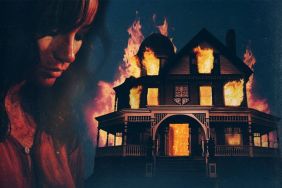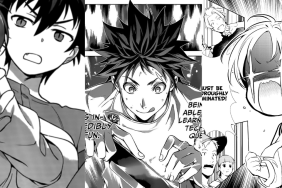Now available on DVD

Cast:
Shelley Winters as Lilith Malone
Belinda Montgomery as Diane Shaw
Robert Foxworth as Steve Stone
Jonathan Frid as Mr. Howard
Martha Scott as Mrs. Stone
Joseph Cotten as Judge Weatherby
Barbara Sammeth as Susan Sanford
Diane Ladd as Alice Shaw
Lucille Benson as Janet Poole
Thelma Carpenter as Margaret Poole
Abe Vigoda as Alikhine
Ian Wolfe as Father MacHugh
Directed by Jeannot Szwarc
Review:
Sure, Leatherface revved his first chainsaw in 1974 and Michael Myers Came Home in 1978 but the most iconic horror villain of the ’70s was no mere slasher. No, the horror villain that proved to be the greatest fiend of the Me Decade was Satan himself, who left an indelible cloven-hoofed imprint on the ’70s. Old Nick may have been around for years, appearing occasionally on such shows as The Twilight Zone (as in the episode “The Howling Man”) but once Rosemaryâs Baby popularized the sub-genre of the satanic thriller in 1968, the Prince of Darkness suddenly found himself in constant demand.
Coming between “Rosemary’s Baby” and “The Exorcist,” the 1973 TV movie “The Devil’s Daughter” starred Belinda Montgomery as Diane Shaw, a young woman who is coping with the recent death of her mother. As we see in a pre-credit sequence, her mother (played by Diane Ladd) ran afoul of The Wicked One himself, who was looking to make good on the long ago deal he made with her (in a witty gesture, we learn that any attempt to thwart the Devil will literally backfire on you). Diane doesn’t know it yet, but her mother whored herself out to Satan. And now that Diane has come of age, it’s she who will have to pay her mother’s debt.
At her mother’s funeral, Diane meets the kindly Lilith (played by Shelly Winters) who introduces herself as an old friend of Diane’s mother. Lilith has a constantly lurking mute chauffer in her employ named Mr. Howard (played by “Dark Shadows’ Jonathan Frid), which should be an early tip-off to Diane that something creepy is going on but nonetheless, she takes the insistent Lilith up on her offer to return to Lilith’s home for lunch. Over lunch and after much affectionate talk about Diane’s mother, Lilith extends an invitation to Diane for the young girl â who is currently living out of a hotel room â to stay with her at her large home. Sure, that might sound nice and all but Diane probably should’ve taken the time to look up from her lunch to notice that a large painting of a demonic figure was hanging directly above her. Again, just one of those telltale signs that you might be in questionable company.
After Diane’s first morning in the accommodating surroundings of Chez Satan, Lilith gives Diane a ring that belonged to her mother. Diane is grateful for the gift but can’t help but notice the strangely ornate design of the ring. And she also can’t help but notice that the same design also appears on the head of the staff held by the demonic figure in Lilith’s painting. Even more incredible is the fact that the same distinctive design is also seen on Lilith’s cigarettes (!). Yes, apparently Satan markets his own brand of smokes!
You know, when you’re part of a group that prefers to go undetected, maybe you shouldn’t label everything you use with such a conspicuous emblem. As “The Devil’s Daughter” goes on, it becomes comical to see these Satanists constantly flaunting their hellish allegiances. One wonders why they don’t just get matching pentagram key chains and “I’d Rather Be In Hell” bumper stickers as well.
Perhaps realizing that due to the public’s familiarity with Rosemary’s Baby that they couldn’t withhold the fact that Lilith and her cohorts are Satanists, writer Colin Higgins (“Harold and Maude,” “Silver Streak”) and director Jeannot Szwarc (“Jaws 2”), quickly let Diane in on the fact that she’s considered the “Princess of Darkness” by Lilith’s sinister crew (which includes the seemingly immortal Abe Vigoda who, for unknown reasons, speaks with a Mexican accent here). “The Devil’s Daughter” then becomes about Diane’s struggle to assert her independence and deny her Satan-spawned birthright.
As the obligatory best friend/innocent victim, Barbara Sammeth plays Susan Sanford, a perky young schoolteacher who Diane moves in with, much to the disapproval of Lilith who responds to the news of Diane’s sudden departure from her home with a ferocious outburst (one of many impromptu screaming fits that Winters entertainingly delivers throughout the course of the film). Susan is instantly earmarked as a likely victim of Lilith’s satanic schemes, as we know her early exit from the story would make Diane an even more vulnerable target. But arriving as a possible added ally against the forces of darkness is Robert Foxworth as Steve Stone, a potential beau of Susan’s (and who sports a perfect ’70s-style Mike Brady perm) who becomes involved with Diane. Will true love be enough to keep the Devil at bay?
Only the most novice of viewers will fail to see early on exactly where “The Devil’s Daughter’s story is heading but Szwarc does a fine job making his film feel more involving than its predictable arc would suggest. It’s brief running time helps as at 73 minutes, Szwarc and scripter Higgins have no choice but to keep their storytelling brisk. The impoverished TV budget shows most in one notable instance as the major death scene of the film â which had the potential to be an effective set-piece â has to occur off-camera. Other than that, Szwarc does an admirable job working within the limits of the low-rent production, and his staging of the finale must’ve been a real goosebump raiser in 1973.
For a relic of a bygone era (in the early moments of the film, there’s so much print damage I thought I had put in “Planet Terror”), “The Devil’s Daughter” is surprisingly spry. It won’t give modern viewers any real jolts but it’s an entertaining yarn, well told. And honestly, what cult movie enthusiast can refuse a film that stars Shelly Winters as a short-tempered Satanist?










